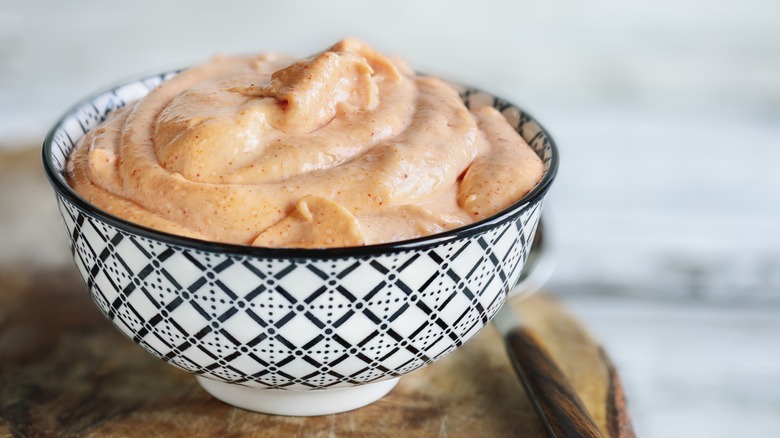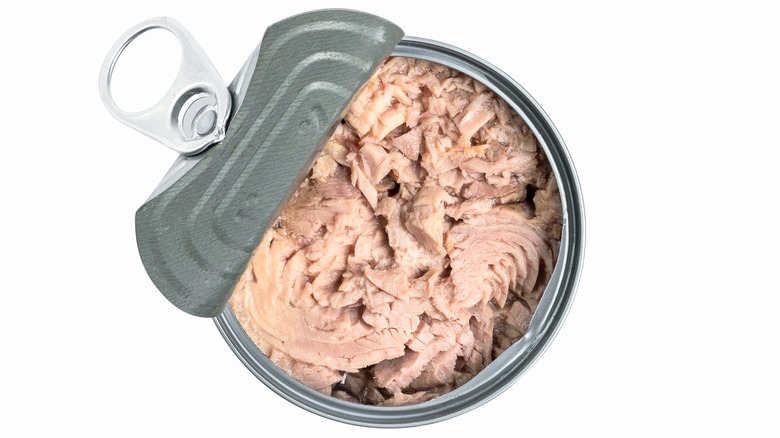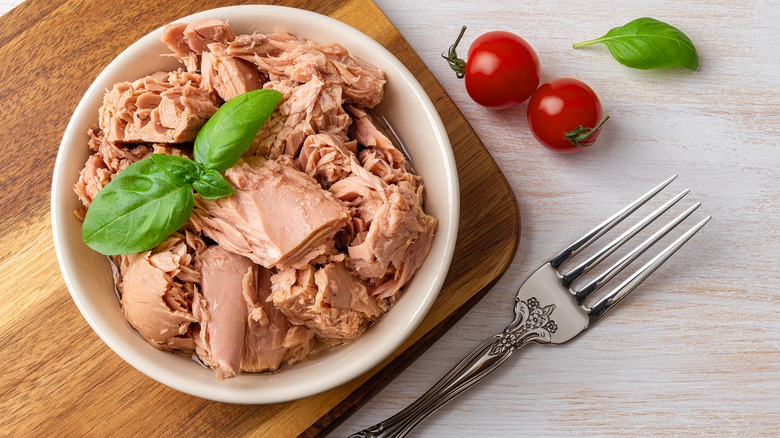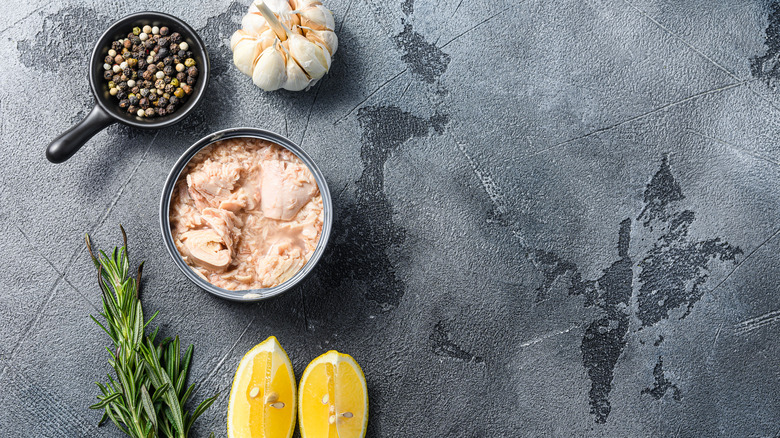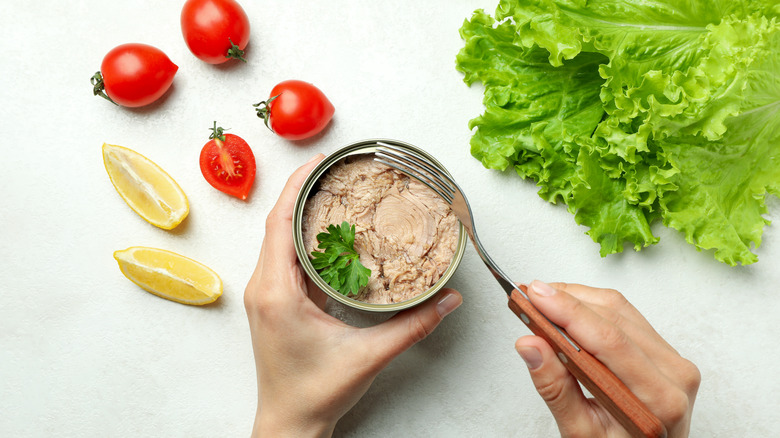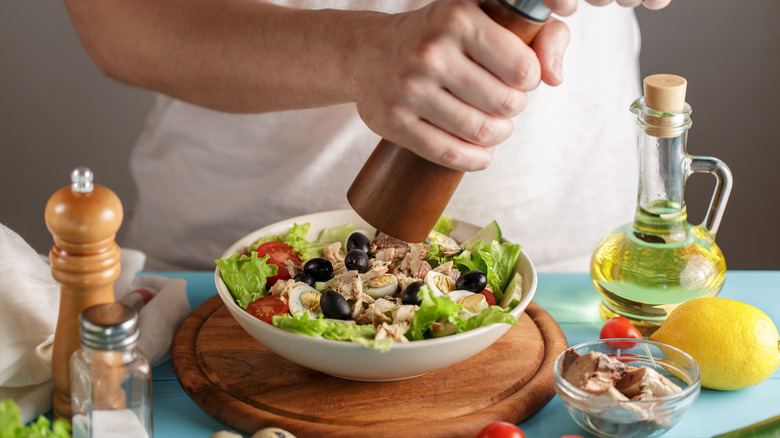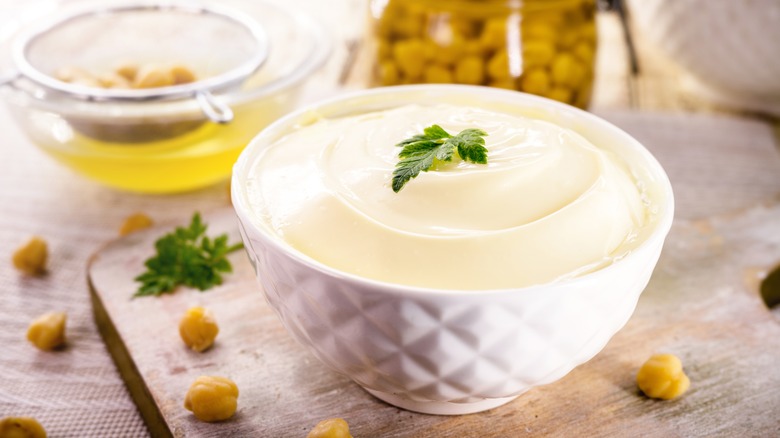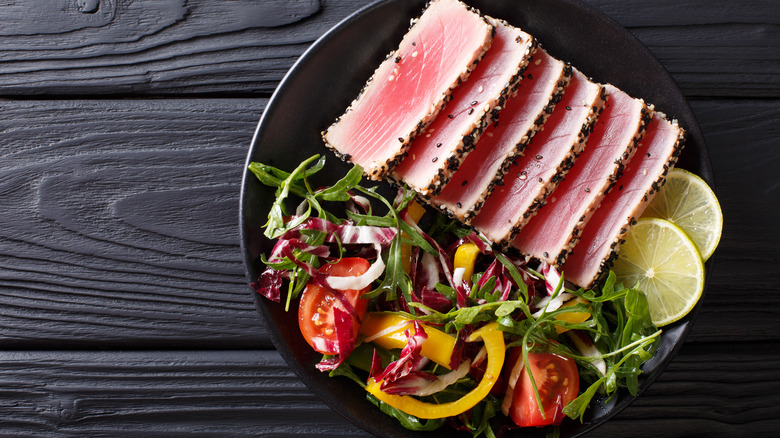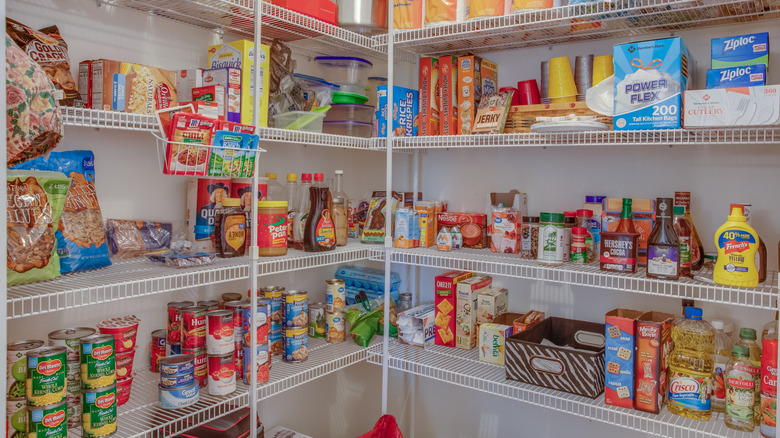11 Mistakes You Didn't Realize You Were Making With Tuna
When it comes to an easy and quick meal idea, few foods come through in a pinch quite like canned tuna. The already-cooked, ready-to-eat protein can become a tasty meal in a matter of minutes, thanks to its best friend mayonnaise and with a little help from a few other choice ingredients in your kitchen. Whether you like to indulge in a savory tuna melt sandwich or meal prep with your favorite tuna salad recipe, there is no denying that canned tuna is a grocery list staple for many.
But what the majority of grocery shoppers may not realize is that canned tuna can come with a myriad of pitfalls and mistakes. These mistakes can be made as early on choosing your tuna in the grocery store, and they can continue through the food prep process. For such a simple ingredient, you would think things would be more straightforward -– and in many ways, it is, as long as you keep a few tips in mind. We have assembled a list of some of the most common mistakes people make when purchasing and eating canned tuna that you need to be aware of if you frequent the canned food aisle at your grocery store.
1. Not buying sustainable tuna
There is a reason one of the largest tuna canning companies in the world is called Chicken of the Sea. Tuna is one of the most popular fish products in the country, according to Monterey Bay Aquarium's Seafood Watch. As such, it is important for the fishing industry to take part in sustainable practices that benefit the consumer as much as it does the supplier and the environment at large. Supporting ethical fisheries also helps to promote the protection of other ocean species, including dolphins, which spawned one of the first movements to ensure canned tuna was harvested responsibly (via cannedtuna.com). Making sure that the tuna you buy in the store is coming from responsibly-sourced fisheries is the first step to avoiding what was once a more common mistake in tuna consumption.
It is much easier these days to find sustainable tuna brands, thanks in part to grocery stores like Whole Foods adopting specific seafood policies, including their canned tuna sourcing policy. If you are shopping at your local market, however, you may also find that responsibly-sourced tuna is more accessible than ever. Tuna that is sustainably canned will be marked. What you will probably find is that many of the popular tuna brands out there are switching to 100% sustainable and responsible suppliers.
2. Not trying different flavors of mayo
Tuna and mayonnaise go together like peanut butter and jelly. But mayonnaise enthusiasts will be quick to tell you that not all brands –or flavors — are the same, and it is important to make sure you are mixing your tuna with the highest-quality, best-tasting ingredients possible.
While traditional mayo lets the other ingredients in your tuna salad shine while giving it more depth with an umami flavor, sometimes it's fun to add an extra kick to the dish. For a unique twist, try Primal Kitchen's chipotle lime with avocado oil, or for something light and fresh add lemon juice, garlic, and fresh or dried herbs to your mayo before mixing it with the tuna. If you like Asian foods, opt for a spicy tuna salad by putting a few drops of sriracha and wasabi in your mayo.
Using different variations of mayonnaise can elevate your tuna salad to the next level. Gone are the days of boring tuna sandwiches!
3. Not choosing low-sodium tuna
Tuna, when eaten in moderation, can offer a slew of health benefits, including a high dose of omega-3 fatty acids (via Livestrong). But like many other foods out there, tuna is best when eaten in moderation. To ensure the benefits outweigh any potential drawbacks, buy canned tuna that is specifically marked as being low-sodium.
Like other canned foods, tuna runs the risk of containing added sodium as a means of preserving the food and extending its shelf life, though the total levels have decreased over time (via Healthline). Still, the best way to avoid sodium altogether is to swap out regular tuna for a low-sodium variety, which can cut out approximately 42.5 milligrams of sodium (via Livestrong).
If you cannot find low-sodium tuna, or if you are working through your supply of tuna, you can still reduce the amount of sodium by rinsing the tuna off in water prior to consumption.
4. Eating too much tuna
In addition to higher levels of sodium (when not choosing low-sodium cans), tuna is one food that contains higher than average levels of mercury. According to the Food and Drug Administration, the average mercury concentration in tuna can range anywhere from 0.13 to 0.69 ppm, with the two extremes of that spectrum being light varieties and bigeye, respectively. For comparison, swordfish, which is notorious for containing higher amounts of mercury, has a mercury concentration of on average 1 ppm. Salmon, on the other hand, is near the bottom of the mercury scale at approximately .02 ppm.
While it is fine to incorporate tuna into your weekly meal planning, it is best to regulate just how much you consume, as eating too much of it can increase the chances of potential risks, especially if you are pregnant or breastfeeding. So while it is totally safe for most individuals to eat canned tuna, do not make it one of the main proteins you eat on a daily basis.
5. Not trying seasoned canned tuna varieties
If your only steps in preparing tuna are draining it out of the can and mixing it into a bowl with mayonnaise, then you are missing out on an entire world of flavor. Not that there is anything inherently wrong with sticking to those two simple ingredients, but if you have never tried adding a third or fourth flavor into the mix, you may not realize what possibilities are out there (including a potential new favorite meal idea). And while you can certainly add your favorite seasonings along the way when making a tuna salad, you can also get a jump start by purchasing packaged or canned flavored tuna.
Flavored tuna ranks high among preferred grocery store finds, including varieties such as honey barbecue as well as simpler flavors like lemon and thyme. If you are at a loss with what to mix in with your tuna, you can also look at the various flavors available in the store to get an idea of what kind of marinades and seasonings would pair well.
6. Not draining the can properly
In most cases, canned tuna is preserved in some form of liquid or oil. It is perfectly fine to consume tuna from the can without draining, but most individuals tend to prefer straining out the liquid before eating. This can be for several reasons, including flavor or texture. However, you can also eliminate quite a bit of sodium simply by draining the can, per Livestrong, so it is worth knowing how to properly do so before adding it to your favorite tuna sandwich or salad.
You also want to consider draining your can of tuna so the liquid does not mess up the texture of the meal you are trying to whip up. The last thing you want is a puddle of salty water getting mixed into your tuna salad, which can unintentionally water down your mayonnaise, making a watery mess. The most efficient way to do this is to simply press the lid of the can down on top of the tuna once opened, squeezing the liquid out with the pressure applied.
7. Only using water-packed tuna
Not all canned tuna is created equal. While there are varieties such as low-sodium, light, and tons of different flavors, there are also different kinds of tuna when it comes to the liquid in which it is preserved. The most common three are oil, water, and brine (via Home Cook World). If you are a creature of habit and only buy tuna that is packed in water, then you may be making a big mistake and missing out on the benefits associated with oil-packed tuna.
Specifically, oil-packed cans of tuna may be your best option if you are a fan of making tuna salads at home. Tuna salad is a great food to make ahead of time in a large batch, whether you are serving a crowd or you are meal-prepping for the family for the week. Using canned tuna that has been packed in oil often gives your dish a richer flavor. It is also preferred by some celebrity chefs, including Ina Garten, who prefers here Spanish tuna packed in oil. The next time you are in the grocery store, skip the water-packed cans of tuna and opt for the oil for a richer dish.
8. Not venturing out there with different ingredients and seasonings
For a food that is quite polarizing, tuna may not seem like a versatile ingredient. But you can actually use the fish in a number of ways beyond a tuna sandwich or a tuna salad for lunch. As it turns out, canned tuna pairs wonderfully with all kinds of ingredients and seasonings that will transform your dish.
Fresh and dried herbs can breathe new life into your tuna salad, and a little squeeze of lemon juice can go a long way. Another pantry staple you may not have considered before is sugar, which is an excellent secret ingredient to kick your tuna salad up a notch. If you are a fan of heat, jalapeños provide just the right kick. If you are interested in adding some spice but not too much, balancing the peppers with sugar can be a great go-to flavor combination.
If you are feeling truly adventurous, try adding peanut butter –- yes, peanut butter -– to your tuna salad. It can be a great combative ingredient against the fishiness of tuna, and you do not need to add too much.
9. Not trying mayonnaise alternatives
Run out of mayo? Reinvent your tuna lunch by swapping out the mayor with a different ingredient that provides a unique flavor or texture. What makes a good mayonnaise substitute? There are actually quite a few options that can create completely different dishes.
While sour cream provides a similar flavor, if you want to upgrade the taste and keep that creamy feel, try a less obvious choice, such as hummus or avocado. HuffPost also recommends trying cottage cheese, tzatziki, and even barbecue sauce as tuna mix-ins.
One of the healthiest mayonnaise substitutes is Greek yogurt, according to Livestrong, which comes packed with added protein. In short, there are probably more mayo substitutes than you realize, so if you want to transform your tuna or simply run out of the condiment, there is no need to run to the grocery store.
10. Only eating canned tuna
What meals come to mind when you think of tuna? They're likely, tuna salads and sandwiches made with canned tuna. But if you only eat canned tuna then you are missing out on a variety of amazing dishes. Fresh tuna opens up an entirely new world of meal possibilities, and it is one form of protein that many prefer to consume raw.
While tuna is popular as sushi, it is also excellent when prepared with a peppery crust, then thinly sliced and served with a spicy sauce on a bed of fresh greens. Give ahi tuna a try the next time you spot it on the menu, or pick up some albacore tuna from your seafood department and try this pan-seared albacore tuna loin recipe. You can also use tuna to make grilled tuna burgers by mixing it with herbs, celery, sesame oil, and ginger for a unique twist to a summertime classic.
11. Not storing it properly
Perhaps the biggest mistake of all when it comes to using canned tuna has nothing to do with the flavor you purchase or the ingredients you use to mix with it. The biggest mistake you can make is storing it improperly.
As with most pantry staples, it is best to keep canned tuna out of direct sunlight and instead store it in a cool, dry place. Letting metal sit in direct light can speed up the rusting or corrosion process, which can make the food inside harmful to ingest, per the University of Minnesota. Additionally, since tuna salad is typically made with mayonnaise, it is not the ideal dish to bring to, say, a summer cookout, since party and picnic foods tend to stay outside for longer than we would like to admit.
When it comes to fresh tuna, it's best to dry the tuna steaks with paper towels to remove extra moisture (via Glad). Then, stack them between paper towels and store them in an airtight bag or container in the fridge or freezer.


